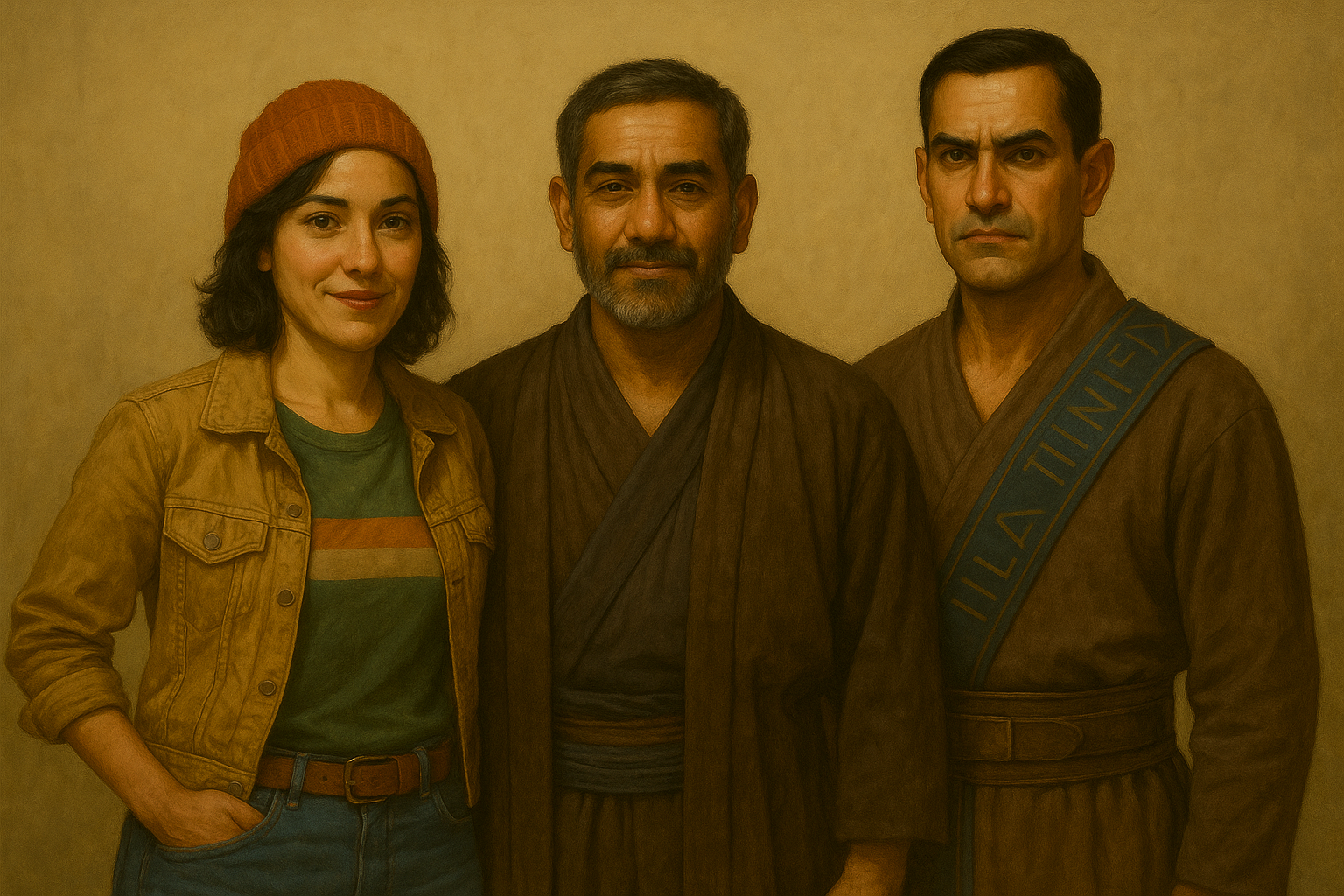Vilani
Appearance
- Complexion deep olive to brown; compact, muscular builds (slightly higher-G heritage).
- Broad shoulders, strong jawlines; hair dark, kept neat or braided.
- Measured posture; economy of movement, deliberate eye contact.
Culture
- Veneration of precedent and bureaucracy; stability over novelty.
- Clan-corporate loyalties; ritualised hospitality and negotiation.
- Archetypes: archivist magistrate, dutiful quartermaster, stoic veteran.
Aesthetics
- Clothing: quilted coats, wrap kilts, high collars, matte textiles.
- Architecture: terraced stone, sunken courts, axial halls, bronze inlay.
- Motifs: stepped geometry, cuneiform fillets, planet-rings.
Historical Context: Vilani Influence in the Core Sector
The Vilani were the first great power to shape the Core, carrying the authority of the Ziru Sirka (First Imperium) into the region more than 7,500 years ago. Though later eclipsed by Solomani conquest and Sylean resurgence, Vilani culture left an indelible mark on the sector. Its echoes can still be seen in local names, caste systems, bureaucratic traditions, and the claims of Core noble houses who trace their descent to ancient Vilani administrators.
Timeline of Vilani Influence
- c. -9100: First Vilani colonisation of the Core, including Sylea. Local humans were absorbed but marginalised. Vilani culture introduced caste structures and bureaucratic government.
- c. -5000: Consolidation of Vilani authority; major Core trade lanes established. The Core became known to the Vilani as Ukan.
- -2400 to -2200: Interstellar Wars. Terran fleets seize parts of the Core from Vland. Vilani names persist, often corrupted into Solomani or Galanglic forms.
- -2200 to -1776: Rule of Man. Terran dominance overlays Vilani traditions but never erases them. Hybrid Vilani–Terran cultures emerge.
- c. -1776: Collapse of central authority ushers in the Long Night. Vilani caste and bureaucratic systems reassert themselves on many Core worlds, providing order amidst decline.
- -900 to -650: Sylea begins its resurgence, drawing on both Vilani and Terran legacies. The Annililik Run re-establishes trade between Sylea and Vland.
- Year 0: The Third Imperium is proclaimed. The Core becomes its heartland, blending Vilani conservatism with Solomani innovation and Sylean vision.
Key Worlds with Vilani Survivals
- Apge (Apge Subsector): The most “Vilani” world in the Core; rigid caste traditions, bureaucratic government, and Vilani language still in use.
- Shudusham (Cemplas Subsector): Nobility claim descent from Ziru Sirka officials; politics and religion steeped in Vilani ritual.
- Hiilev (Cemplas Subsector): Home of the Hiidamo, a Vilani-derived human Minor Race adapted for the world’s environment.
- Vashugan (Kaskii Subsector): Bureaucratic traditions dominate; advancement through mastery of precedent and law.
- Shululsu (Apge Subsector): Preserved Vilani arts and texts in monastic archives throughout the Long Night.
Legacy
The Core today is neither wholly Vilani nor Solomani, but a fusion of both traditions shaped by Sylean leadership. Vilani influence persists most clearly in its conservatism, its respect for hierarchy, and the bureaucratic structures that underpin Imperial governance. The nobility of many Core worlds still invoke Vilani ancestry as a claim to legitimacy, and the Imperial heartland remains steeped in their ancient cultural memory.
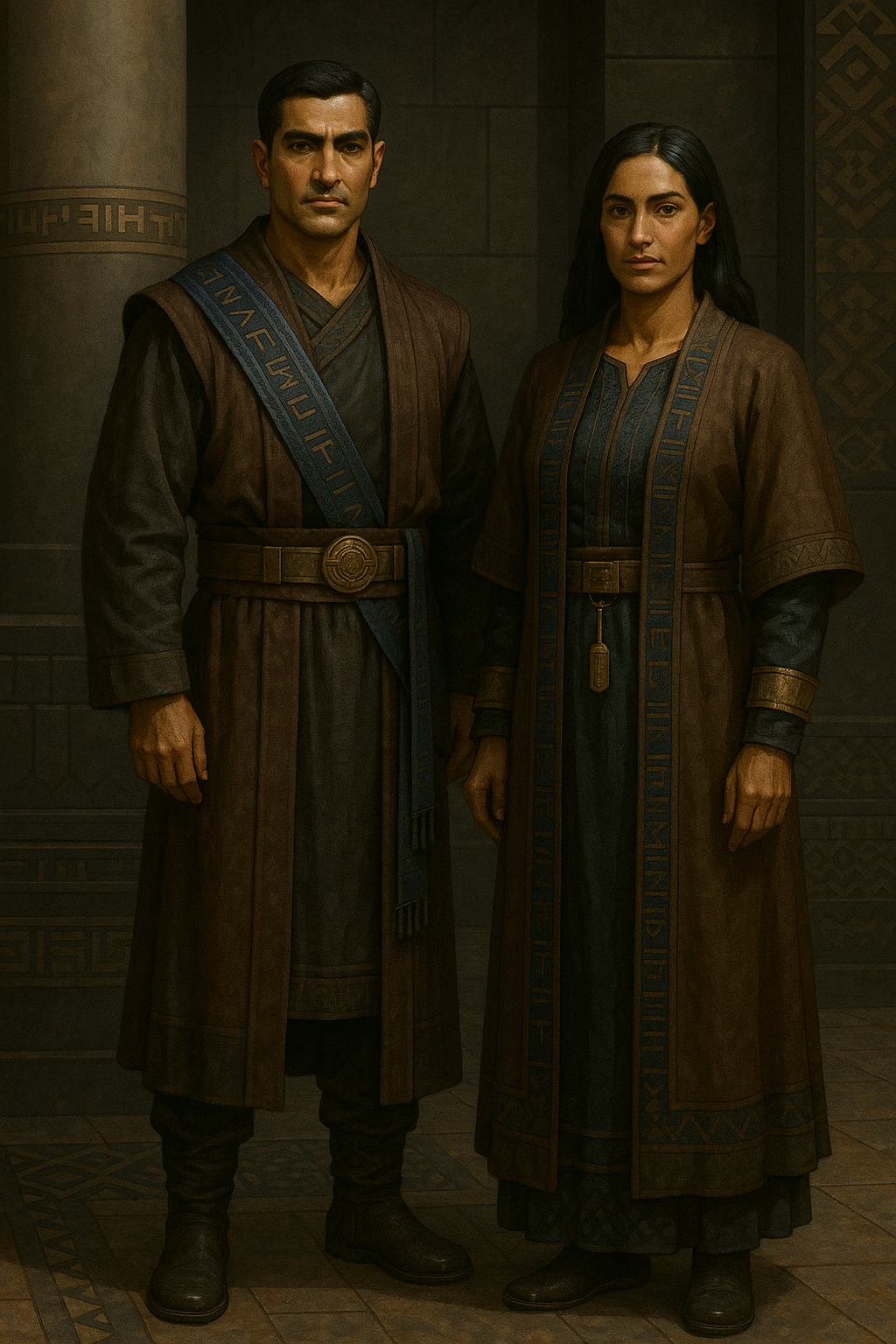
Solomani (Core)
Appearance
- All Terran ethnicities present; average builds; confident gait.
- Hair and style vary widely; expressive micro-gestures, fast speech.
Culture
- Meritocratic hustle; brand consciousness; civic clubs & guilds.
- Archetypes: free trader, media fixer, naval reservist, NGO advocate.
Aesthetics
- Clothing: tailored jackets, utility boots, smart wearables.
- Architecture: glass-steel stacks, skybridges, pocket parks.
- Motifs: neon signage, transit maps, mid-century revival.
Historical Context: Solomani Influence in the Core Sector
The Solomani entered the Core much later than the Vilani, but their impact was swift and transformative. Arriving as conquerors during the Interstellar Wars, they imposed their culture, language, and institutions upon the region. Although their direct dominance was brief compared to Vilani centuries, Solomani influence reshaped the Core’s identity, creating the hybrid society from which the Third Imperium eventually arose.
Timeline of Solomani Influence
- -2400 to -2200: The Interstellar Wars. Terran fleets break Vilani control of Ukan (the Core). Star systems are seized, renamed, and reorganised under Terran command.
- -2200 to -1776: The Rule of Man. The Core becomes a centrepiece of the “Second Imperium.” Terran settlers, officials, and soldiers introduce Terran law, custom, and speech. Vilani systems are often retained but blended with Terran practices.
- -2000 to -1800: Rapid demographic change as Solomani migration brings new populations, accelerating the fusion of Terran and Vilani stock.
- -1776: Collapse of the Rule of Man. The Core, like the rest of Charted Space, descends into the Long Night. Solomani institutions vanish but Galanglic, a descendant of Terran English, remains as the lingua franca.
- -900 to -650: Surviving Core states—especially Sylea—retain Solomani traditions of innovation, free trade, and representative government. These elements will be fused with Vilani conservatism to form the bedrock of the Sylean Federation.
- Year 0: The proclamation of the Third Imperium by Cleon I enshrines Solomani values of innovation and expansion into Imperial culture, balanced by Vilani traditions of hierarchy and order.
Cultural Impact
- Language: Galanglic, derived from Terran English, became the trade language of the Core and later the official language of the Imperium. Its dominance is the most visible Solomani legacy.
- Institutions: Terran ideals of innovation, democracy, and civic law informed the early Sylean Federation and survive in Imperial tradition, though often tempered by Vilani caution.
- Identity: Solomani influence encouraged the Core to see itself as forward-looking and dynamic, counterbalancing Vilani conservatism. This duality remains central to Imperial self-image.
- Names: Many Core systems retain Solomani-era names imposed during the Interstellar Wars, layered atop older Vilani nomenclature.
Legacy
The Solomani presence in the Core was comparatively brief, but its effects endure. Their language became the lingua franca, their emphasis on innovation shaped Imperial technology, and their political ideals influenced Sylean statecraft. The Imperium itself can be seen as a fusion: Vilani bureaucracy and conservatism tempered by Solomani dynamism and Sylean vision. The Core remains the crucible where these legacies merged into the dominant culture of Charted Space.
Solomani-Influenced Worlds of the Core
- Capital / Sylea (Capital Subsector): Originally a Vilani colony, Sylea absorbed vast numbers of Terran settlers during the Rule of Man. Terran ideals of innovation, trade, and representation shaped its government, culminating in the Grand Senate of the Sylean Federation.
- Vland Corridor Worlds (Annililik Run): Several waystations and colonies along the route between Vland and Sylea were repopulated by Terrans during the Rule of Man. These worlds often retain Terran-derived names and dialects of Galanglic distinct from Vilani speech.
- Chant Subsector (Core): Contains worlds where Solomani settlers established industrial colonies during the Rule of Man. Some still show architectural and cultural markers of Terran origin, from legal codes to city design.
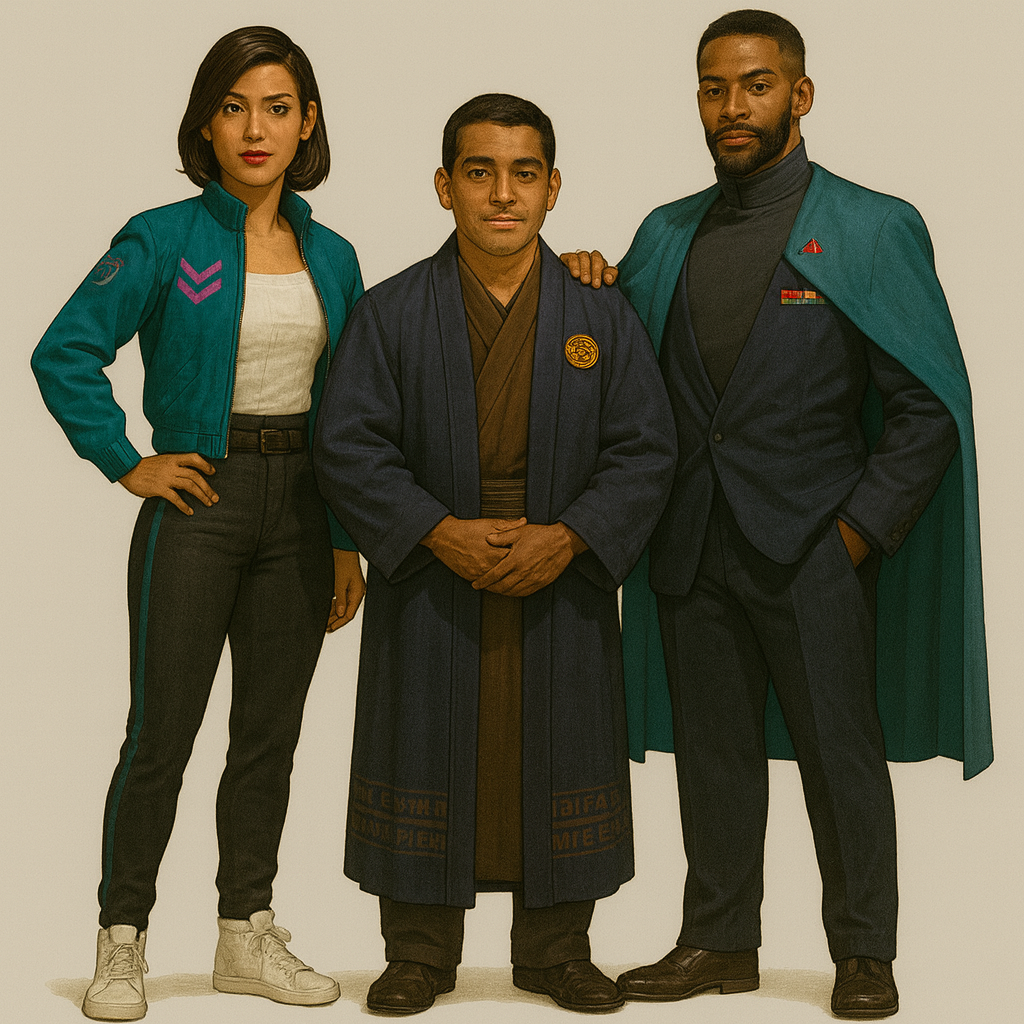
Chanestin
Appearance
- Features recalling Slavic–Mayan blend; tall and slender.
- Hair dark to auburn; posture attentive; curious gaze.
Culture
- Scholarly artisan guilds; calendrics; river-city republics.
- Archetypes: observatory cartographer, jade-textile merchant, ritual mathematician.
- Aloof and separatist; Chanestin-first, with distaste for non-Chanestin institutions.
Aesthetics
- Clothing: woven geometrics, sashes, meteor-stone beads; 18th-century Slavic fairytale.
- Architecture: stepped terraces, observatories, canal gardens.
- Motifs: suns, serpents, star glyphs.
Historical Context: The Chanestin Kingdom
Dates: c. -1300 to Year 2
Region: Core Sector (primarily Dunea subsector)
The Chanestin Kingdom was one of the longest-lived successor states of the Long Night, founded by King Brzeszcze on Keshi around -1300. Drawing on substantial stores of starships and materiel, Brzeszcze unified nearby systems into a monarchy that at its height spanned 25 star systems within five parsecs of Keshi.
Government and Society
The Kingdom was a feudal monarchy, with Keshi as its capital and royal seat. Rule was centralised in the person of the King and his noble vassals. Conquered worlds were generally left to manage their own affairs unless they resisted, in which case they were crushed and brought to heel. Chanestin society valued loyalty, martial prowess, and heritage, and cultivated a distinct identity apart from neighbouring states.
Technology
Though once advanced, the Kingdom stagnated at TL9. By -108, it had only one operational jump-capable vessel. Its fortunes changed in -107 when a Sylean trade mission was seized at Keshi, and its crew executed. The captured ships allowed Chanestin engineers to reverse-engineer jump technology, revitalising their fleet. This act set the stage for nearly a century of war with the rising Sylean Federation.
Wars with Sylea
- Early Chanestin successes were enabled by copied Sylean vessels and aggressive raiding.
- Major battles included Velpare, Heraldia, and the long sieges of Keshi’s spinward client worlds.
- Chanestin fleets launched deep raids into Sylean space as late as -25, harassing supply lines and striking poorly defended frontier systems.
- Sylean technological superiority at TL11–12 gradually eroded Chanestin strength.
- In -3, the Syleans committed their full navy, and by Year 2 the Chanestin Kingdom had been decisively conquered.
Integration into the Imperium
The monarchy was abolished; compliant nobles received Imperial patents, while others were stripped of their titles or executed. Many Chanestin worlds declined for centuries under Imperial administration, falling further behind technologically. Keshi, however, emerged as a cultural and spiritual centre, preserving Chanestin architecture, art, and ritual. The palaces, museums, and grand avenues of Keshi remain major tourist draws today.
Modern Era
Chanestin heritage is celebrated across Keshi, Khea, and other former core worlds of the Kingdom. Festivals, memorials, and museums commemorate the Kingdom’s resistance to Sylea and the Imperium. Periodic calls for a Chanestin Cultural Zone (similar to those granted to the Luriani or Lancians) remain controversial within the Moot. Granting such recognition might stabilise the region, but opponents argue it risks reviving separatism.
Imperial forces maintain a strong naval presence at Uundizi (132nd Fleet), and several Chanestin worlds remain Amber Zones due to separatist activity and anti-Imperial unrest.
Significance
The Chanestin Kingdom represents both the endurance and limits of Long Night polities. Its survival for over a millennium, its long war with Sylea, and its enduring cultural pride make it a defining example of the resistance to Imperial expansion. Today it is remembered as a proud and stubborn culture, still marked by suspicion of Imperial authority and still fiercely protective of its heritage.
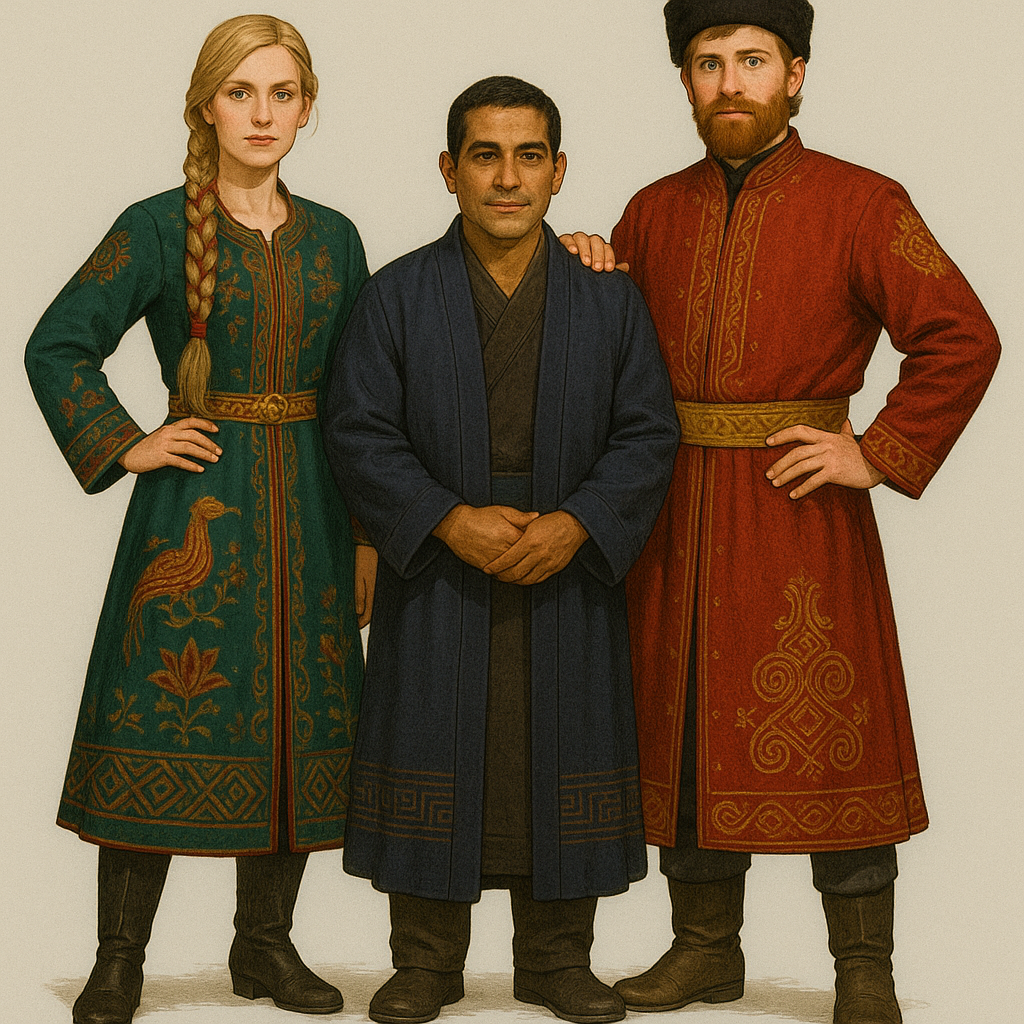
Sylean
Appearance
- Very tall (some to 2.1m+); near-albino skin; jet-black hair in ringlets or sculpted waves.
- Graceful carriage; minimal expression; immaculate grooming.
Culture
- Civic classicism; public ritual; consensus-seeking elites.
- Archetypes: tribunal orator, archivist-priest, aesthetic engineer.
Aesthetics
- Clothing: white/pastel robes, gilded trim, sandals, statement jewelry.
- Architecture: colonnades, void-glass, sunken forums, acoustic domes.
- Motifs: laurel, star-arches, monochrome mosaics.
- Religion: intensely personal ethnoreligious gnostic mysticism not discussed with outsiders.
Historical Context: Sylean Federation / Sylean Worlds
Dates: -650 to Year 0 (as Federation)
Region: Core Sector (Capital subsector and surrounding)
The Syleans are a distinctive branch of Humaniti seeded on Sylea by the Ancients. Physically they are recognisable—tall, pale-skinned, dark-haired, and striking-eyed—but their significance lies not in appearance, but in culture. For thousands of years they endured marginalisation under both the Vilani Ziru Sirka and the Terran Rule of Man. From this long oppression grew a people defined by endurance, spirituality, intellectual tradition, and stubborn pride. They are often described as well-educated and contemplative, valuing knowledge and philosophy above brute strength or physical dominance.
Origins and Early History
Sylea was colonised by the Vilani c. -9100. For millennia the Syleans were little more than provincial subjects of Vland. During the Rule of Man, however, Solomani overlords elevated Syleans into positions of influence. This unexpected recognition sparked a cultural renaissance—art, philosophy, and scholarship flourished, even as the wider Rule collapsed. The Long Night left Sylea bruised but unbroken, its traditions intact.
The Federation (-650 to Year 0)
In -650 the monarchy of Sylea fell to a popular uprising, replaced by the Grand Senate and an elected presidency. This was the birth of the Sylean Federation, whose ideals of shared governance, civic virtue, and collective destiny would shape history. By -500 the Federation encompassed 18 worlds. Contact with Vland was re-established in -495, creating the perilous Annililik Run, a narrow corridor of trade and diplomacy between Sylea and the ancient Vilani.
The Federation expanded rapidly, but its Senate was often divided between Democrats (who favoured cautious governance), Expansionists (who demanded aggressive growth), and Industrialists (who pursued profit and technological dominance). Despite political wrangling, the Federation’s technological drive accelerated. The great shipbuilding concern GSbAG rose to near-monopoly power by -334, providing fleets of jump-capable warships.
Wars and Struggles
The Federation proved its mettle in conflict. Against the Interstellar Confederacy (-301 to -201) it fought a long, grinding war of attrition. Against the Chanestin Kingdom (-108 to Year 2) it faced a stubborn and proud foe, whose defiance tested Sylean resolve for nearly a century. These wars hardened the Federation, instilling doctrines of logistics, centralised command, and naval supremacy that would later define the Imperium.
Yet the Federation also suffered internal strains. By the -200s piracy surged across its trade routes. Senate paralysis and ineffective leadership threatened collapse. It was during this crisis that Cleon Zhunastu rose to prominence. A reformer and visionary, Cleon reorganised the Scouts, expanded industrial production, and bound nobles, corporations, and citizens alike to his cause.
Birth of the Imperium
By -100 the Federation spanned dozens of parsecs, but its Senate was paralysed and its unity fragile. Cleon consolidated power, presenting himself as the saviour of Humaniti’s future. In Year 0, he declared the formation of the Third Imperium, transforming the Federation into its imperial core. Only eight of the Sylean Federation’s member worlds accepted immediately; the so-called Wayward Worlds resisted but were eventually brought into the fold.
Sylean Cultural Zone
Today, the Sylean Worlds retain recognition as a cultural region of the Imperium. Visitors often remark that Sylean society feels subtly alien even within the heart of the empire. Their worlds emphasise contemplation, spirituality, and family life; their cities avoid ostentatious displays of technology, preferring understated elegance and cultural refinement. The Syleans are renowned for their education, diplomacy, and philosophical traditions, but less for martial strength—indeed, it is often said they “rule by wisdom, not by the sword,” though history shows they have mastered both when required.
Significance
The Syleans were not the most numerous of Humaniti’s branches, nor the most physically formidable, but they were the most ambitious. Their vision of order, unity, and destiny transformed a fading federation into the Third Imperium, and their homeworld, Sylea—now Capital—remains the seat of Imperial power.
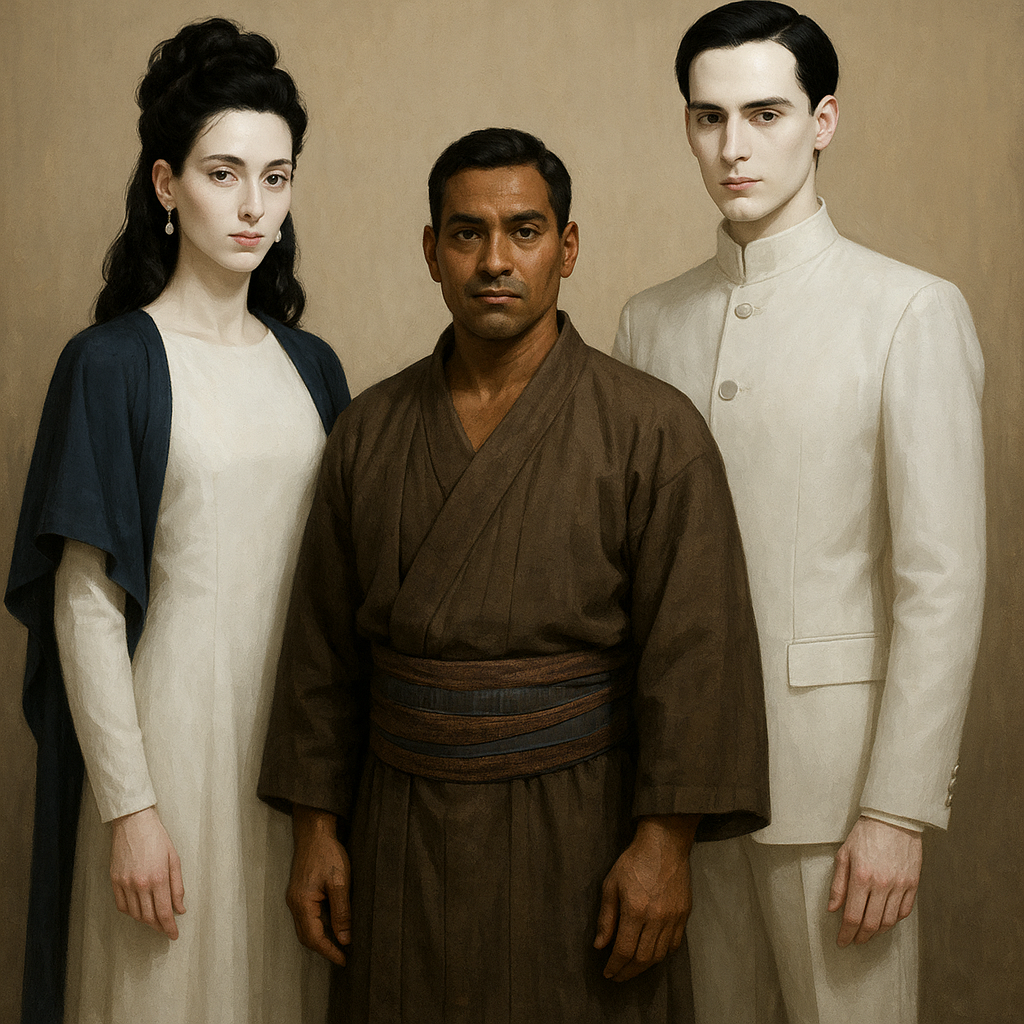
Shaaki (Core)
Appearance
- Mixed ancestries; practical hair; oil-etched hands; sturdy builds.
- Direct eye contact; wary humour; proud stance.
Culture
- Shop-floor solidarity; can-do improvisation; tea-break diplomacy.
- Archetypes: line lead, tool-and-die whisperer, safety steward, scrapyard broker.
Aesthetics
- Clothing: boilersuits, flat caps, hi-vis overcoats; grease-scarred boots.
- Architecture: brick mills, gantry forests, sodium lamps, pub canteens.
- Motifs: chevrons, hazard stencils, enamel signs.
Historical Context: The Shaaki
The Shaaki are a culturally distinct human population of the Core Sector, descended from populations displaced during an ecological catastrophe and subsequent resettlement in the early Third Imperium. Today they are concentrated in the Ameros and Dunea subsectors, with their core worlds being Ase, Umgadin, and Xalm, and with a significant diaspora elsewhere.
Origins and Ecological Collapse
The Shaaki trace their identity to the industrial world of Shaaak (later renamed Syroe), only a parsec from Sylea. During the early Imperial period, Shaaak pursued industrialisation with little restraint. By the mid-230s, the planet’s ecology was collapsing: toxic air, mass extinctions, poisoned soil, and rising illness devastated its population.
Emperor Martin II judged that such a disaster on Capital’s doorstep was intolerable. He ordered a programme of deindustrialisation and mass resettlement, moving millions aboard fleets of cheap, disposable one-shot and two-shot jump craft. These desperate voyages scattered the displaced across nearby systems, where they forged a new collective identity as the Shaaki.
Resettled Worlds
- Ase: The most successful Shaaki world, becoming an industrial powerhouse with rich planetoid belts.
- Umgadin (Uunli): A secondary industrial giant, almost the twin of Ase, supplying raw materials and skilled labour to the wider Core.
- Xalm: Initially promising but struck by financial, political, and ecological crises. Xalm’s decline is often cited as the tragic counterpoint to Ase’s prosperity.
- Affinity (Vlaakier): Founded during the exodus but developed into a more cosmopolitan trade hub, culturally Shaaki but never fully integrated with the Cluster.
- Syroe (formerly Shaaak): The original homeworld, renamed during its ecological rehabilitation. Today it is independent and does not identify with the Shaaki, though its history defines them.
Legacy
Shaaki culture revolves around labour, community, and endurance. Family and “shift-clan” identity dominate social life. Disputes are resolved through negotiation by elders or by practical contests of skill and strength. The Shaaki are seen across the Core as hardworking, plain-spoken industrial folk—sometimes dismissed as parochial, but widely respected for reliability and resilience.
The Shaaki represent both the promise and peril of industrial modernity. Their labour built much of the Core’s starports, fleets, and orbital infrastructure. Yet their origin in ecological catastrophe gives their culture a sombre undertone—a memory of how overreach and exploitation can destroy even the greatest of worlds.
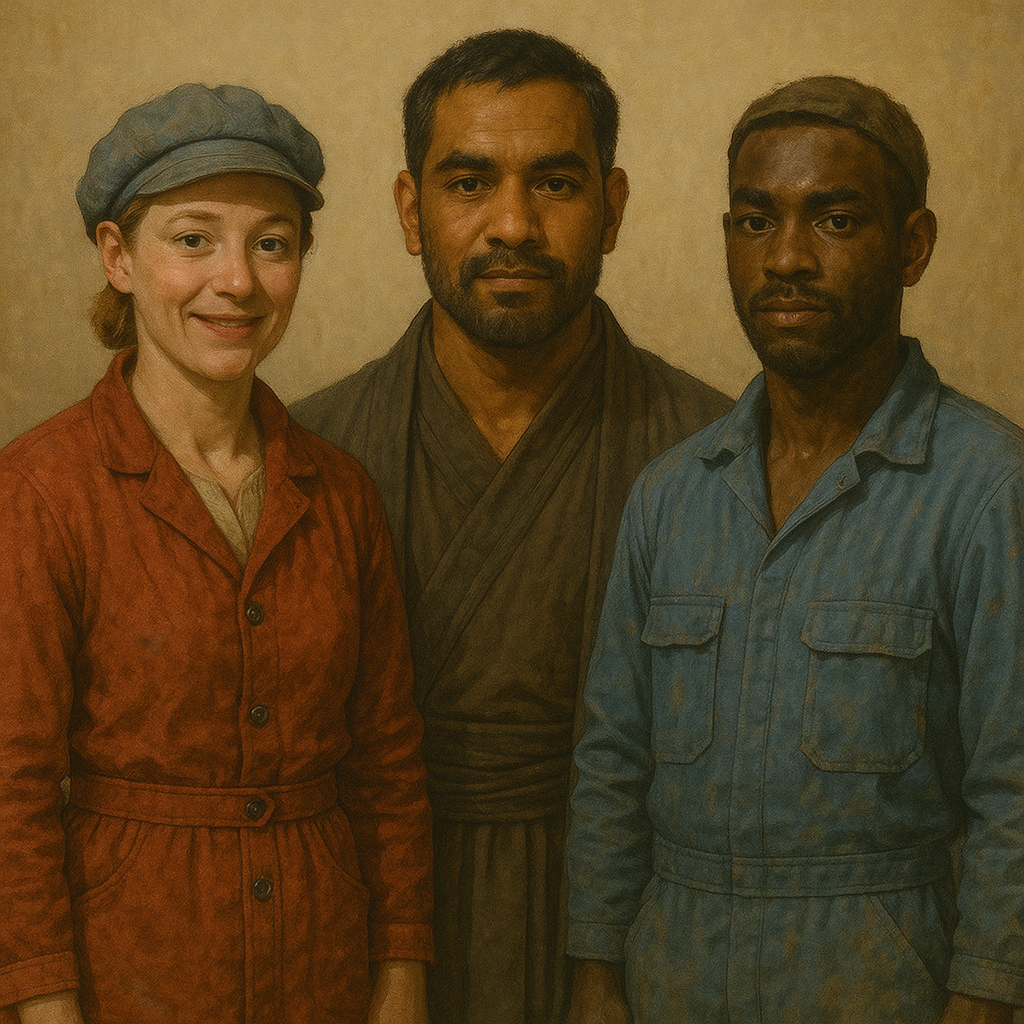
Average Imperial
The everyday people of the Core — ˜3,000 years of continual ethnic admixture across Vilani, Solomani, Sylean and countless local cultures. Not an elite caste but the default urban citizenry of the Third Imperium’s heart.
Appearance
- Wide phenotypic range: Vilani-leaning builds are common; Sylean height appears but varies; Solomani diversity in skin tones, hair and features.
- Grooming from practical to polished; hairstyles span neat crops, curls/ringlets, and protective styles; accessories mix heirloom pieces with smart wearables.
- Confident, metro-honed posture; mixed accents and code-switching are normal.
Culture
- Pluralist imperial civic culture: neighbourhood guilds, transit citizenship, and festival calendars blending Vilani precedent with Solomani innovation.
- Anglic as lingua franca with Vilani/Sylean loanwords; court ceremony is known but distant — most identity is municipal or professional.
- Archetypes: transit engineer, port clerk, holo-editor, boutique broker, services petty officer, museum-docent coder.
Aesthetics
- Clothing: tailored utility (jackets, boots, uniforms-as-streetwear), occasional gold trim or civic pins on formal days.
- Architecture: baroque-futurist public halls, panoramic observation lounges, efficient housing stacks, art-lined transit hubs.
- Motifs: star-crests, transit sigils, arched windows, curated civic art — “museum-ship” sensibility diffused into everyday Core life.
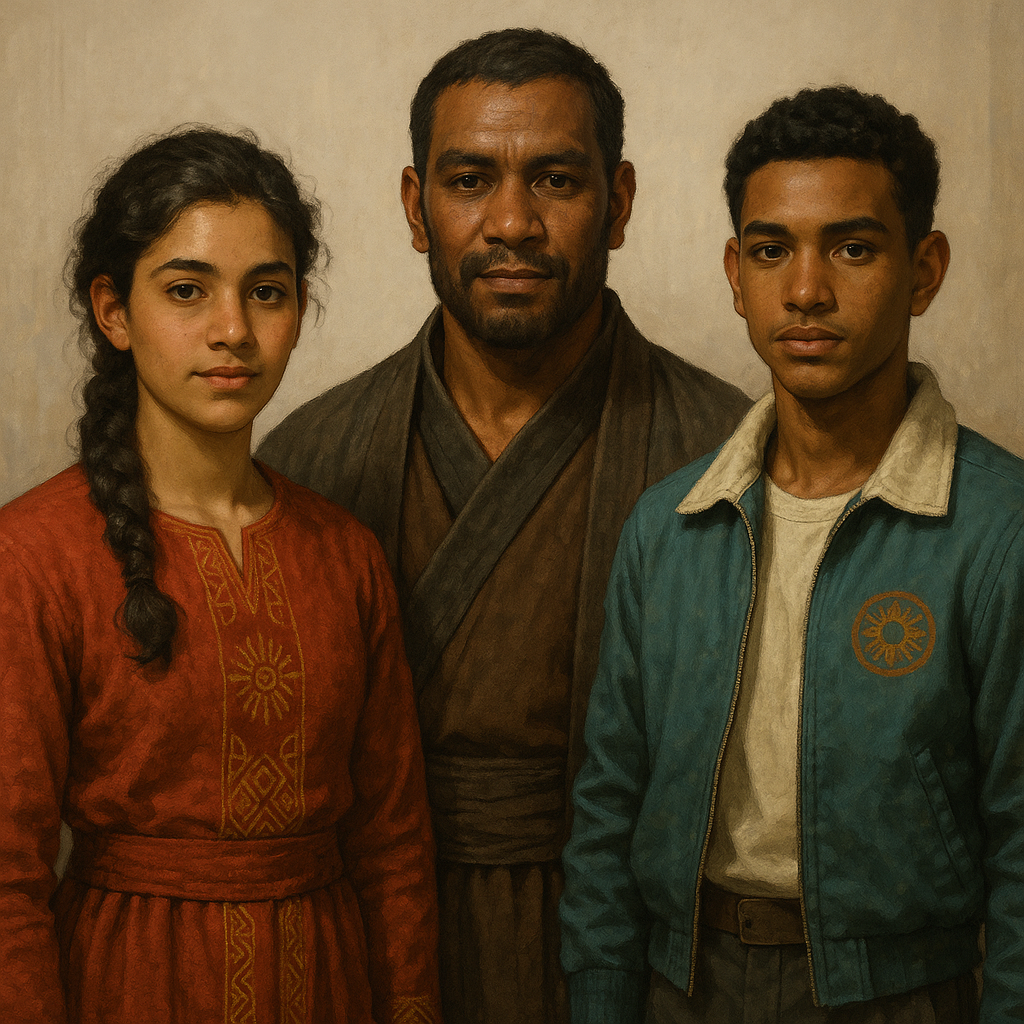
Interstellar Confederacy
Overview
Dates: -684 to -1
Region: Core Sector (primarily Bunkeria and Cemplas subsectors)
The Interstellar Confederacy was a major pocket empire that flourished during the Long Night. Founded in -684 by Rom Debeshuut of Sketola, it united the so-called Great Spiral of worlds into a defensive and trade-oriented union. Its purpose was to preserve high technology and maintain interstellar commerce in a time when many regions had regressed to pre-spaceflight levels.
Government
The Confederacy was ruled by a Grand Senate based on Sketola, where each member world sent delegates “as equals.” Though idealistic in conception, the Senate became increasingly conservative over time. After expanding to 32 worlds by -623, the Confederacy closed its doors to further members, fearing that overexpansion would dilute its ability to maintain technological parity.
Technology
Confederacy worlds maintained technology up to TL12, making them one of the most advanced polities of the Long Night. A hallmark of its success was the preservation of sophisticated starship construction and interstellar trade lines, notably through the Achenaar Antilles Line, a merchant corporation still active today.
Conflict with Sylea
Contact with the growing Sylean Federation in -301 quickly degenerated into hostility. A series of naval skirmishes culminated in the Battle of Velpare (-258), where Sylean forces routed a Confederacy fleet but failed to capture the planet. Open warfare persisted for decades, with worlds such as Velpare and Heraldia falling to Sylean conquest by -201.
Civil War
In -239, internal divisions erupted when rebels from the spinward arm seized Sketola. The capital was retaken two years later, but unity never recovered. Weakened by infighting, the Confederacy proved unable to resist continued Sylean pressure.
Fall
By -100, most of its territory had been absorbed by Sylea. The last remnants surrendered in -1, just before the proclamation of the Third Imperium.
Legacy
- Many former Confederacy worlds, especially in Cemplas, retain cultural pride and a degree of suspicion toward Imperial authority.
- Memorials, festivals, and museums in the region commemorate the Confederacy’s resistance.
- The Achenaar Antilles Line endures as a Core-wide shipping concern, a lasting monument to Confederacy commercial achievement.
Significance
Once a serious rival to Sylea, the Confederacy’s refusal to expand, its rigid conservatism, and internal civil wars sealed its fate. Its story remains a cautionary tale of the dangers of stagnation in interstellar politics.
